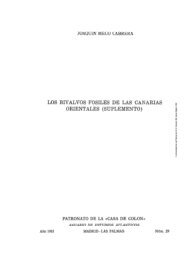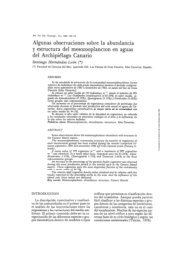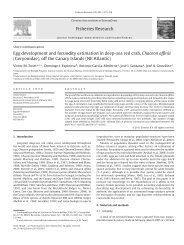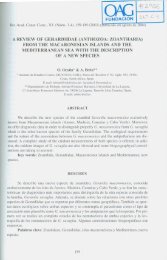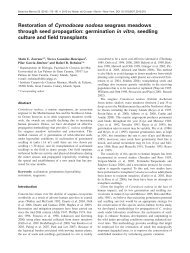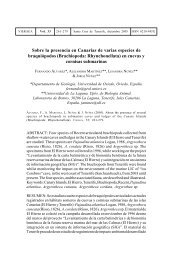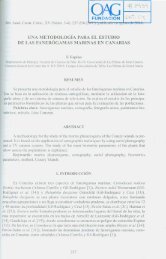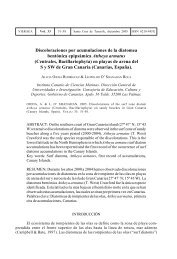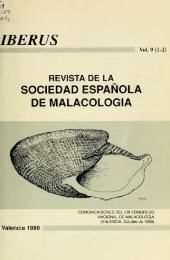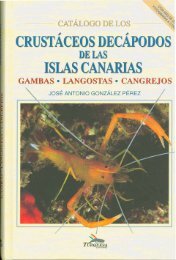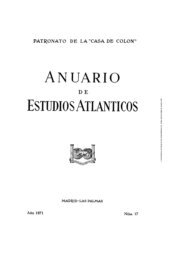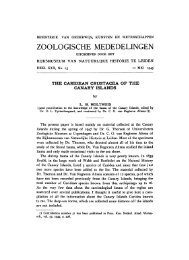of the madeira and selvagens archipelagos - redmic
of the madeira and selvagens archipelagos - redmic
of the madeira and selvagens archipelagos - redmic
Create successful ePaper yourself
Turn your PDF publications into a flip-book with our unique Google optimized e-Paper software.
S<br />
40<br />
35<br />
30<br />
25<br />
20<br />
15<br />
10<br />
5<br />
0<br />
0,07 0,07<br />
0,51<br />
0,93<br />
3,33<br />
Global Madeira Porto Santo Desertas Selvagens<br />
Figura 1. Riqueza específica em taxa (S) e riqueza especifica por unidade de área (Km 2 ) (valores acima das barras) das classes do Phylum Chordata nos<br />
arquipélagos da Madeira e Selvagens (Global) e nas várias ilhas (ver igualmente o Quadro 1 do capítulo 1).<br />
Figure 1. Species richness (S) <strong>and</strong> species richness per unit <strong>of</strong> area (Km 2 ) (values above bars) <strong>of</strong> all classes belonging to <strong>the</strong> Phylum Chordata in <strong>the</strong><br />
<strong>archipelagos</strong> <strong>of</strong> Madeira <strong>and</strong> Selvagens, <strong>and</strong> on <strong>the</strong> various isl<strong>and</strong>s (see also Table 1 <strong>of</strong> chapter 1).<br />
4. Padrões biogeográficos<br />
É de esperar que as ilhas oceânicas apresentem um<br />
conjunto de espécies que não seja representativo daquelas<br />
que ocorrem nos continentes, o que é geralmente designado<br />
por desarmonia taxonómica (Whittaker 1998). Este<br />
fenómeno deve -se, por um lado, ao facto de as ilhas oceânicas,<br />
pelo seu isolamento, dificultarem a chegada de espécies<br />
e, por outro, à diferente capacidade de dispersão<br />
de diferentes taxa. A desarmonia taxonómica foi avaliada<br />
nos arquipélagos da Madeira e Selvagens para o grupo<br />
mais diverso de vertebrados, as aves. O número de ordens<br />
e a contribuição relativa de cada ordem para a riqueza de<br />
espécies e subespécies foram comparados com os dados<br />
do arquipélago das Canárias (que tem a mesma fonte de<br />
espécies nativas do que a Madeira e Selvagens: a Europa)<br />
e de Portugal continental, seguindo as recomendações taxonómicas<br />
sugeridas por Cramp (1998).<br />
Segundo a lista apresentada por Cabral et al. (2005),<br />
Portugal continental tem mais de 96% das ordens de aves<br />
(segundo Cramp 1998) dadas para a Europa, est<strong>and</strong>o apenas<br />
ausente de Portugal continental uma ordem apenas<br />
conhecida no norte da Europa e América. A ordem Pscitaciformes<br />
foi incluída nestas análises, apesar de não ser<br />
considerada originária da Europa e de todas as espécies<br />
presentes em Portugal serem introduções recentes. Seis<br />
das ordens que ocorrem em Portugal continental não ocorrem<br />
nos arquipélagos da Madeira e Selvagens (tendo em<br />
conta a lista apresentada por Oliveira & Menezes 2004),<br />
nem no arquipélago das Canárias (lista apresentada por Izquierdo<br />
et al. 2001). Nove ordens estão presentes nas três<br />
Ilhas (isl<strong>and</strong>s)<br />
361<br />
4. Biogeographical patterns<br />
Actinopterygii<br />
Amphibia<br />
Reptilia<br />
Aves<br />
Mammalia<br />
Oceanic isl<strong>and</strong>s are difficult to reach, <strong>and</strong> since organisms<br />
<strong>of</strong> different taxa have different dispersal abilities it is inevitable<br />
that <strong>the</strong>se isl<strong>and</strong>s will possess a non -representative<br />
sample <strong>of</strong> species from <strong>the</strong> mainl<strong>and</strong> (<strong>the</strong> so -called “taxonomic<br />
disharmony”) (Whittaker 1998). In <strong>the</strong> Madeira <strong>and</strong><br />
Selvagens <strong>archipelagos</strong> this was studied for <strong>the</strong> most diverse<br />
group <strong>of</strong> vertebrates present, birds. The number <strong>of</strong><br />
orders <strong>and</strong> <strong>the</strong>ir proportional contribution to species <strong>and</strong><br />
subspecies richness was compared to findings in <strong>the</strong> Canary<br />
Isl<strong>and</strong>s <strong>and</strong> mainl<strong>and</strong> Portugal (<strong>the</strong> taxonomic recommendations<br />
presented by Cramp (1998) were followed). To<br />
underst<strong>and</strong> <strong>the</strong> reasoning for this analysis it is important to<br />
note that all <strong>the</strong> native birds <strong>of</strong> <strong>the</strong>se two <strong>archipelagos</strong> are<br />
from European origin.<br />
Considering <strong>the</strong> list <strong>of</strong> species presented by Cabral et al.<br />
(2005) for mainl<strong>and</strong> Portugal more than 96 % <strong>of</strong> <strong>the</strong> European<br />
orders (as proposed by Cramp 1998) are present; only one,<br />
with a nor<strong>the</strong>rn European <strong>and</strong> American distribution, is absent.<br />
Though considered in our analysis, <strong>the</strong> Pscitaciformes<br />
are not an order with an original European distribution; all<br />
<strong>the</strong> species present are recent introductions. Six orders that<br />
occur on mainl<strong>and</strong> Portugal are absent from <strong>the</strong> Madeira <strong>and</strong><br />
Selvagens <strong>archipelagos</strong> (according to <strong>the</strong> list presented by<br />
Oliveira & Menezes 2004) <strong>and</strong> <strong>the</strong> Canary Isl<strong>and</strong>s (according<br />
to <strong>the</strong> list present by Izquierdo et al. 2001); nine are simultaneously<br />
present in <strong>the</strong> three areas, while one occurs only in<br />
<strong>the</strong> Madeira <strong>and</strong> Selvagens <strong>archipelagos</strong> <strong>and</strong> mainl<strong>and</strong> Portugal<br />
<strong>and</strong> four only occur in <strong>the</strong> Canary Isl<strong>and</strong>s <strong>and</strong> mainl<strong>and</strong><br />
Portugal (Fig. 2). This clearly shows that <strong>the</strong> bird Fauna from



